Due to the long construction time required, as well as the Moorish influence in the Iberian Peninsula, several of Spain's cathedrals are often an eclectic mix of Romanesque, Gothic, Baroque, Neoclassical and Mudéjar styles.
In the Middle Ages, the first portion of the building built would be the main altar and apse. After that the construction was followed with the crossing at the transept and the nave. It was during this time that Spain's great Gothic cathedrals such as those at Burgos, Toledo, and León, were built. At the dawn of the Renaissance, Spain saw herself commanding an empire in the new world. Spanish cathedrals began to incorporate newer classically-based architectural styles as seen in Granada Cathedral. Later, wealth from the Americas financed ornate Baroque architecture such as a new façade for the Romanesque cathedral of Santiago de Compostela or the Basilica of el Pilar in Zaragoza. In post-Gothic styles, Spanish cathedrals departed from the usual Latin-cross shape and developed more open designs (such as in the neo-classical cathedral of Cádiz). A handful of Spanish cathedrals contain touches of modern architecture. The Almudena Cathedral in Madrid was not finished until 1993, and the completed church is decorated with much more modern designs than other cathedrals in the country.
Today the cathedrals of Spain draw visitors from around the world each year, forming a significant part of the country's tourist trade especially those which were influenced by the Gothic style. This period was a time of cities, of guilds and merchants… and of cathedrals. The artistic expression known as the Gothic style evolved in the lower Middle Ages between the 12th and 15th centuries. The gradual disappearance of the feudal bonds, the resurgence of the cities, an ever more prosperous commercial sector and the progressive humanisation of the Christian doctrine served as a fertile breeding ground for this art form. The city became the main centre of activity and took on the role of cultural repository which had hitherto been solely reserved to the monasteries. In Spain, this was the time of the great cathedrals which soared up towards the sky in search of divinity. There are over 80 cathedrals in Spain and these are the top 10 Gothic styled cathedrals the country has to offer.
1. León Cathedral

The León Cathedral, dedicated to Santa María de la Regla, was declared of Cultural Interest in 1844. It is known as the Pulchra Leonina and is a masterpiece of the Gothic style dominating the mid-13th century, by master architect Enrique. By the late 16th century it was virtually completed. The main façade has two towers. The southern tower is known as the 'clock tower'. The interior represents a combination of architecture, painting, sculpture and other arts. The Renaissance retrochoir contains alabaster sculptures and the choir was built by three great artists: Jusquin, Copin of Holland and Juan de Malinas. Particularly noteworthy is the Plateresque screen in the wall behind the sepulchre of King Ordoño. It has three portals decorated with sculptures situated in the pointed arches between the two towers. The central section has a large rose window. Particularly outstanding is the image of the Virgin Blanca and the Locus Appellatione, where justice was imparted.
Its almost 1,800 square meters of stained glass windows are one the main touristic attractions of the cathedral. The great majority of them are original, which is a rarity, and date from the thirteenth to the fifteenth century. They are among the world's finest stained glass works.
2. Burgos Cathedral
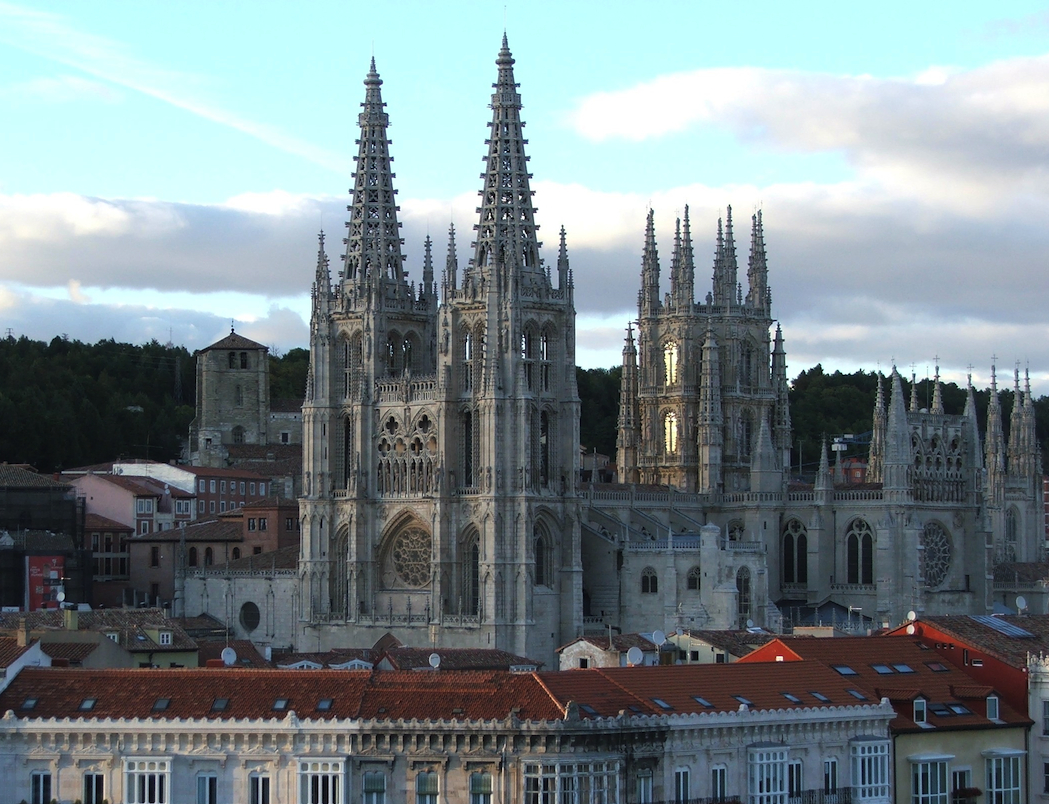
Burgos Cathedral was dedicated to the Virgin Mary and is famous for its vast size and unique architecture. Its construction began in 1221 and it was in use as a church nine years later but work continued off and on until 1567. It was primarily built in the French Gothic style, although Renaissance style works were added in the 15th and 16th centuries.
The cathedral was declared a World Heritage Site by UNESCO on October 31, 1984. It is the only Spanish cathedral that has this distinction independently, without being joined to the historic center of a city.The architects who directed its construction were a Frenchman in the 13th century and a German in the 15th century. In 1417, the bishop of Burgos attended the Council of Constance and returned with the master builder John of Cologne (Juan de Colonia), who completed the towers with spires of open stonework tracery.
3. Toledo Cathedral

The cathedral of Toledo is one of the three 13th-century High Gothic cathedrals in Spain and is considered, in the opinion of some authorities, to be the magnum opus of the Gothic style in Spain. It was begun in 1226 under the rule of Ferdinand III and the last Gothic contributions were made in the 15th century when, in 1493, the vaults of the central nave were finished during the time of the Catholic Monarchs. It was modeled after the Bourges Cathedral, although its five naves plan is a consequence of the constructors' intention to cover all of the sacred space of the former city mosque with the cathedral, and of the former sahn with the cloister. It also combines some characteristics of the Mudéjar style, mainly in the cloister, and with the presence of multifoiled arches in the triforium. The spectacular incorporation of light and the structural achievements of the ambulatory vaults are some of its more remarkable aspects. It is built with white limestone from the quarries of Olihuelas, near Toledo.
4. Avila Cathedral
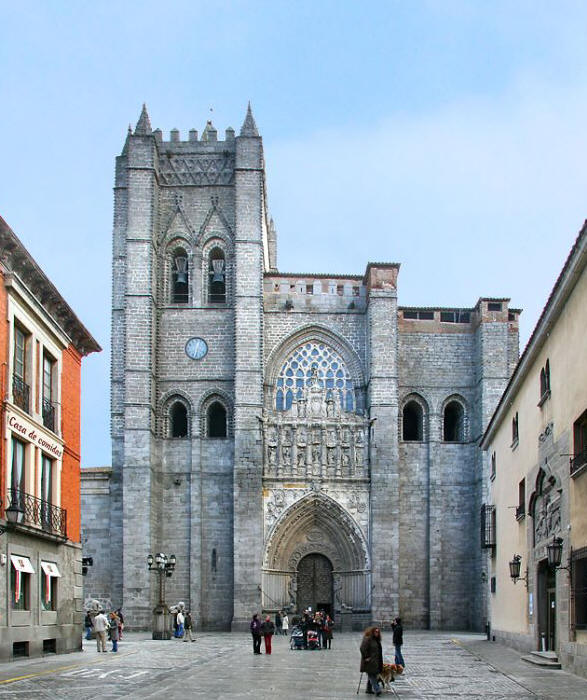
The Cathedral of Ávila is in the south of Old Castile. It was planned as a cathedral-fortress, its apse being one of the turrets of the city walls. It is surrounded by a number of houses or palaces, the most important being: the Palace of the Evening, the Palace of the Infant King, and the Palace of Valderrábanos, which were responsible for the defence of the Puerta de los Leales (The Gate of the Loyal Ones) also known as La Puerta del Peso de la Harina (The Flour Road Gate). It is not known exactly when the construction of the Cathedral began, there being two theories. One states that Alvar Garcia started its construction in 1091 inside the remains of the Church of the Saviour, which was in ruins as a result of successive Muslim attacks, and that Alfonso VI of Castile raised the money necessary to build it. Other historians believe the Cathedral to be the work of the maestro Fruchel in the 12th century coinciding with the repopulation of Castille led by Raymond of Burgundy.
5. Cuenca Cathedral
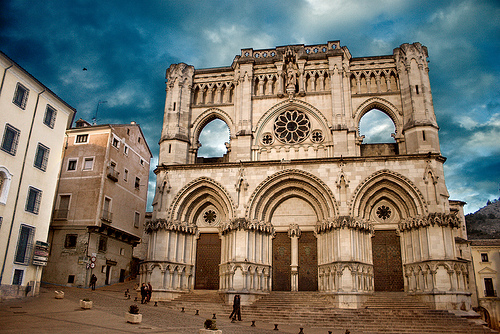
Cuenca Cathedral lies in the Castile-La Mancha region of south-eastern central Spain and is an exceptional expression of Gothic Anglo-Norman, begun in 1196. The wife of King Alfonso VIII, Eleanor Plantagenet of England, daughter of King Henry II Plantagenet of England and Eleanor of Aquitaine, Duchess of Aquitaine, Sister of Richard the Lionheart, who inspired this cathedral. The influence of the Norman court of King Alfonso VIII, defined the construction of this cathedral, the first Gothic cathedral of Castile, together with that of Avila. Work began in the year 1196 and was completed in 1257.
It has a Latin cross plan, the arm of the cross reaching from the main entrance to the altar is considerably longer than the other arms, and a seven-sided polygonal apse. The facade was rebuilt by Vicente Lampérez in the early twentieth century.
6. Seville Cathedral
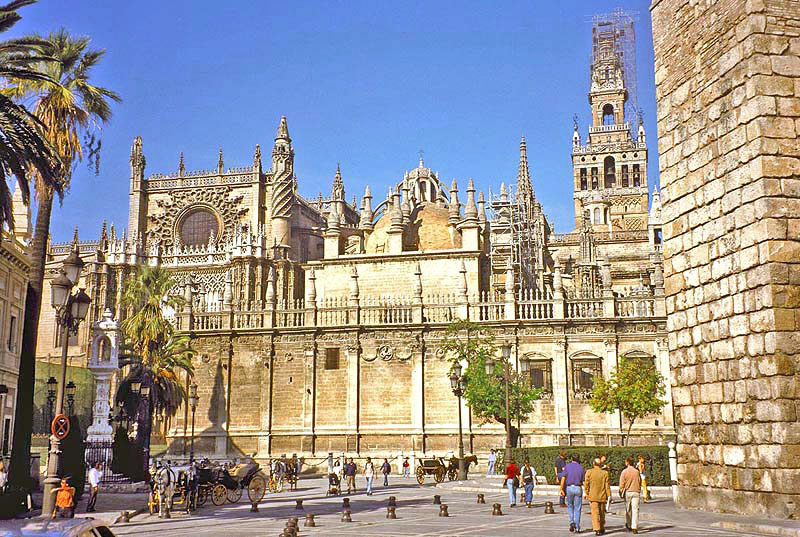
Seville Cathedral was built to demonstrate the city's wealth, as it had become a major trading center in the years after the Reconquista in 1248. In July 1401 it was decided to build a new cathedral since the structure of the current building, an ancient Muslim mosque which had been converted into a Christian church, was so badly damaged by the 1356 earthquake. According to local oral tradition, the members of the cathedral chapter said: "Let us build a church so beautiful and so great that those who see it built will think we were mad". Construction began in 1402 and continued until 1506. The clergy of the parish gave half their stipends to pay for architects, artists, stained glass artisans, masons, carvers, craftsman and labourers and other expenses.
Five years after construction ended, in 1511, the dome collapsed and work on the cathedral recommenced. The dome again collapsed in 1888, and work was still being performed on the dome until at least 1903. The 1888 collapse occurred due to an earthquake and resulted in the destruction of "every precious object below" the dome at that time.
7. Segovia Cathedral
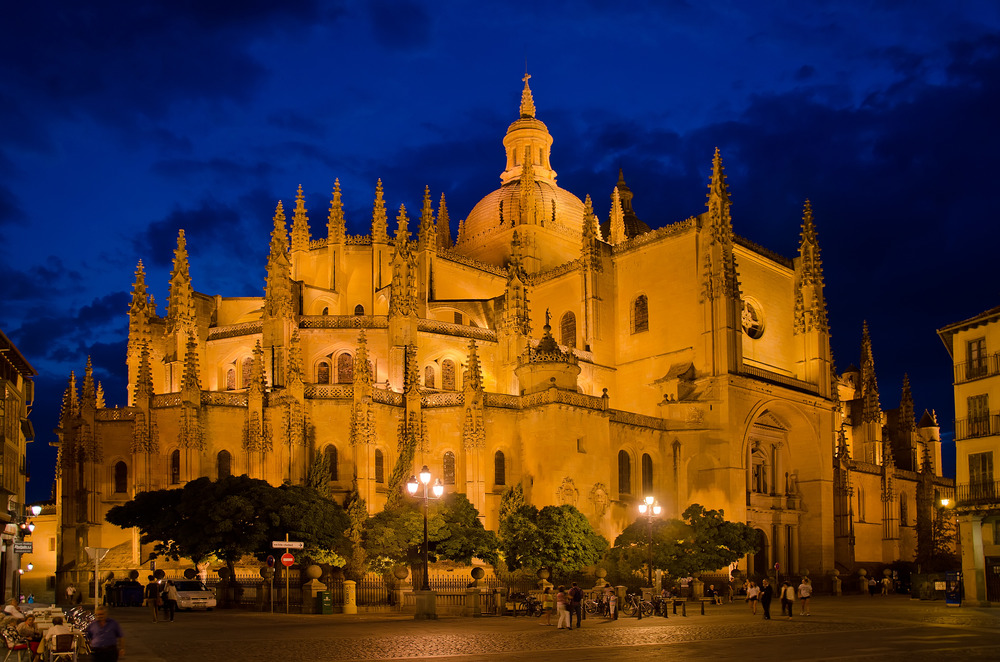
The massive cathedral was built between 1525-1577 in a late Gothic style, an architectural style that was becoming retardataire elsewhere in Europe. The prior cathedral of Segovia had stood adjacent to the Alcazar, and had been used by the besieged royal armies in their defense. The rebellious Comuneros were intent on taking the Cathedral to protect its holy relics, and to use its position against the walls of the Alcazar in order to defeat its defenders. In a famous exchange, prominent city officials urged the comuneros to halt their attacks on the church that they should consider the injustice of razing a temple, so sumptuous, while making war against those who serving their king, defended his Alcazar. But their plea fell on deaf ears, and the comuneros replied: la Iglesia era de la Ciudad (the Church belonged to the City). After a bitter siege lasting months, the cathedral lay in ruins.
Fearful of a repeat assault, the cathedral was relocated to the present site and built using a design by the Trasmeran mason named Juan Gil de Hontañón, and the work was continued by his son Rodrigo Gil de Hontañón.
The building has a structure in three tall vaults and ambulatory, with fine tracery windows set, and numerous stained glass. The interior is characterized by unity of style (late Gothic), except for the dome, built around 1630 by Pedro de Brizuela. Gothic vaults rise to 33 meters high and measures 50 meters wide and 105 long. The bell tower reaches almost 90 meters. The current stone spire crowning the tower, dating from 1614, was erected after a major fire caused by a thunderstorm. The original spire, entirely Gothic, was built of American mahogany had pyramidal structure, and was the tallest tower in Spain.
8. Oviedo Cathedral
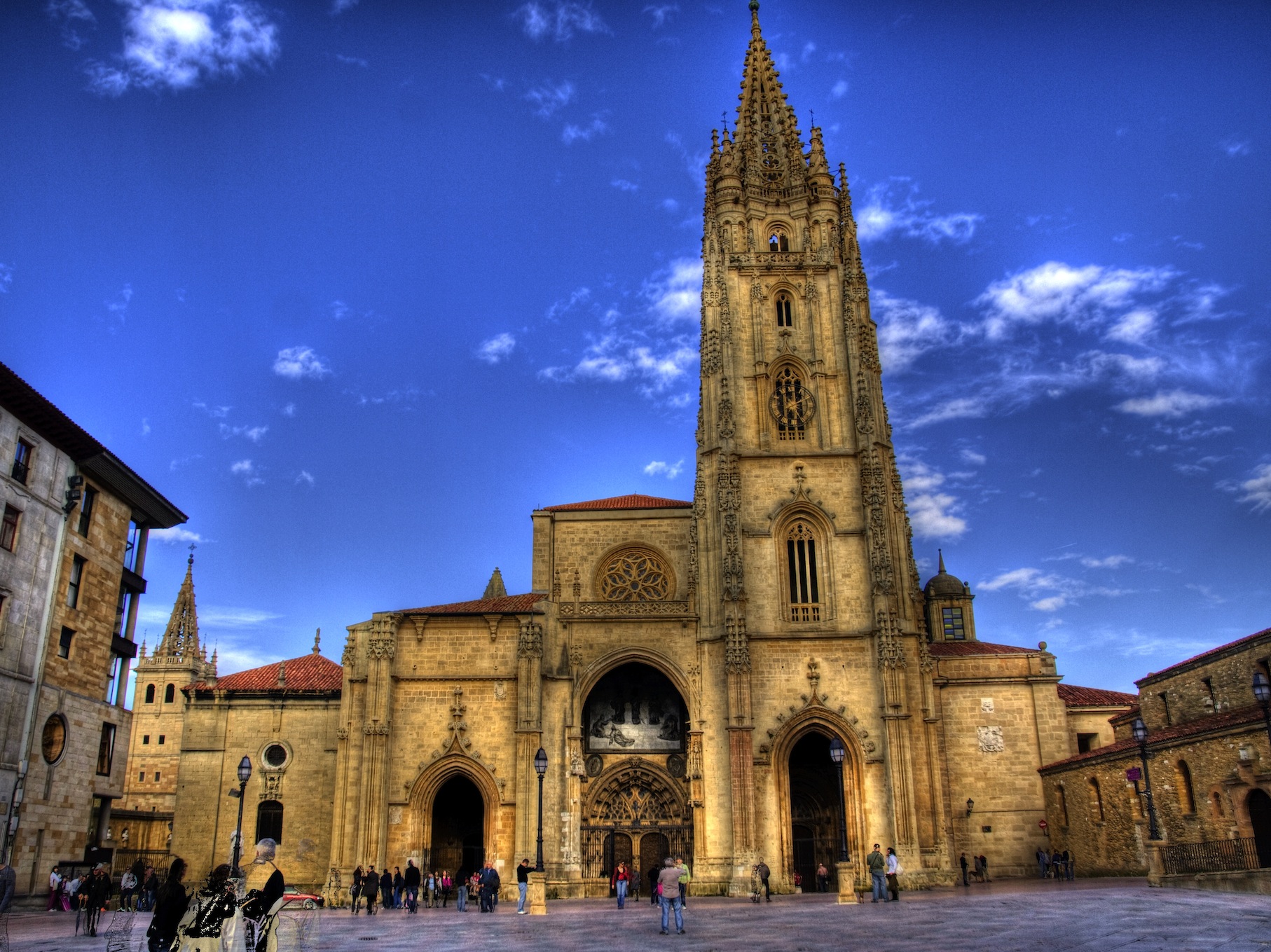
The cathedral of San Salvador is mainly a fine Gothic building, which was built between 14th and 16th centuries in a Classic and Flamboyant Style. The Chapter Room, whose construction was started in 1388, was the first part of the new Gothic cathedral to be finished: built in a classic Gothic fashion (including a great eight-sided dome), it was followed by the cloister and the choir (ca. 1400). The naves were built once the choir was finished, all through the 15th century. We can admire the progression of the constructive stages, taking as an example the tracery of windows and tryphorium. The sanctuary is still a classical-Gothic work, whereas the naves present typical flame-like elements typical of a late-Gothic style.
9. Barcelona Cathedral
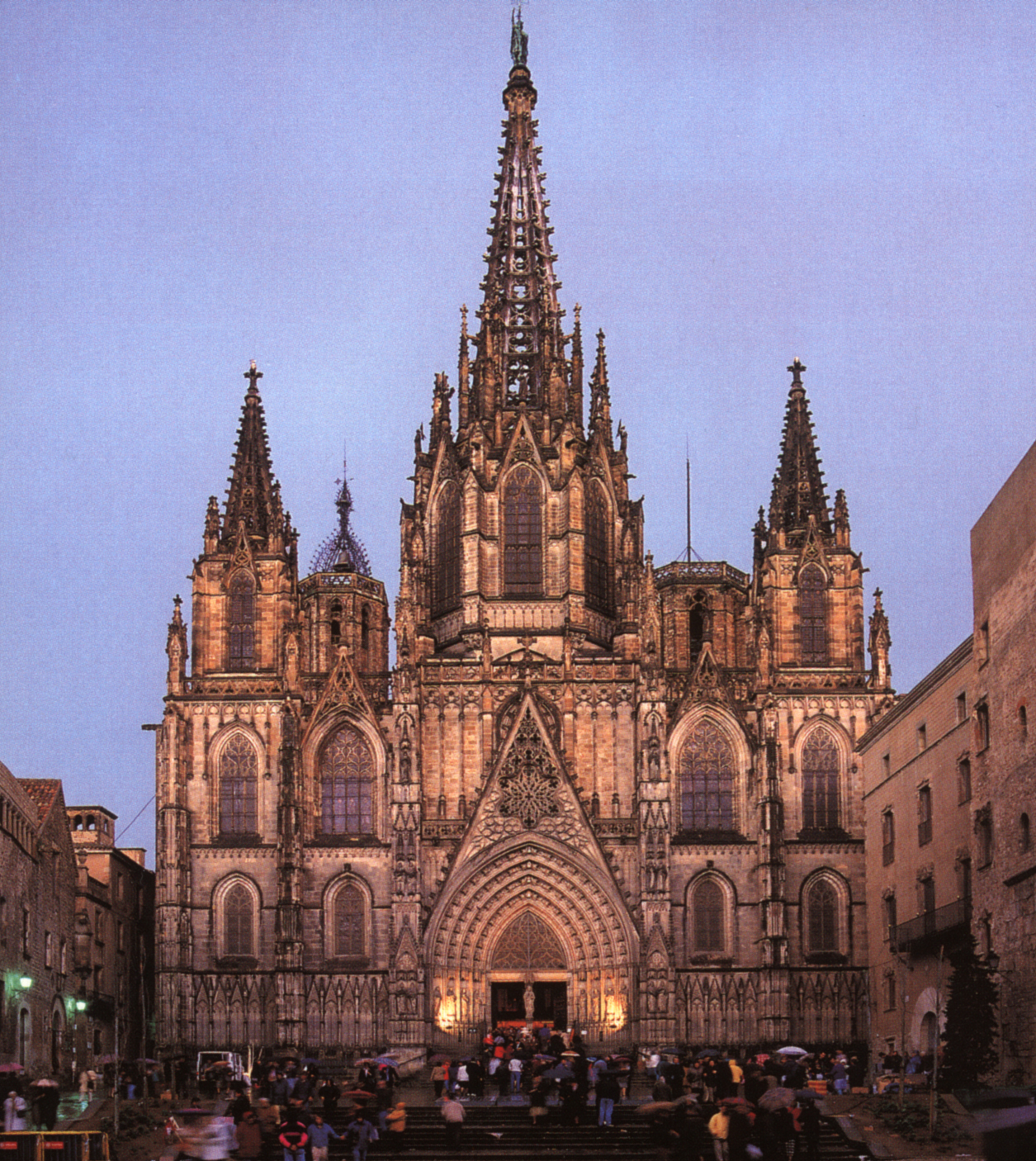
Barcelona Cathedral, is the Gothic cathedral and seat of the Archbishop of Barcelona. The cathedral was constructed from the 13th to 15th centuries, with the principal work done in the 14th century. The cloister, which encloses the Well of the Geese (Font de les Oques) was completed in 1448.In the late 19th century, the neo-Gothic façade was constructed over the nondescript exterior that was common to Catalan churches. The roof is notable for its gargoyles, featuring a wide range of animals, both domestic and mythical.
It is a hall church, vaulted over five aisles, the outer two divided into chapels. The transept is truncated. The east end is a chevet of nine radiating chapels connected by an ambulatory. The high altar is raised, allowing a clear view into the crypt.
The cathedral is dedicated to Eulalia of Barcelona, co-patron saint of Barcelona, a young virgin who, according to Catholic tradition, suffered martyrdom during Roman times in the city. One story says that she was exposed naked in the public square and a miraculous snowfall in mid-spring covered her nudity. The enraged Romans put her into a barrel with knives stuck into it and rolled it down a street (according to tradition, the one now called Baixada de Santa Eulàlia). The body of Saint Eulalia is entombed in the cathedral's crypt.
10. Palma de Mallorca Cathedral

The Cathedral of Santa Maria of Palma, more commonly referred to as La Seu (a title also used by many other churches), is a Gothic Roman Catholic cathedral located in Palma, Majorca, built on the site of a pre-existing Arab mosque. It is 121 metres long, 55 metres wide and its nave is 44 metres tall. Designed in the Catalan Gothic style but with Northern European influences, it was begun by King James I of Aragon in 1229 but finished only in 1601. It sits within the old city of Palma atop the former citadel of the Roman city, between the Royal Palace of La Almudaina and the episcopal palace. It also overlooks the Parc de la Mar and the Mediterranean Sea.
In 1901, fifty years after a restoration of the cathedral had started, Antoni Gaudí was invited to take over the project. While some of his ideas were adopted – moving the choir stalls from the middle nave to be closer to the altar, as well as a large canopy – Gaudí abandoned his work in 1914 after an argument with the contractor. The planned changes were essentially cosmetic rather than structural, and the project was cancelled soon after.